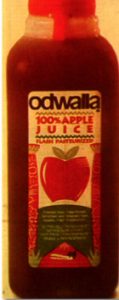This is why avant-garde jazz saxophonists shouldn’t be responsible for food safety
And that’s nothing against avant-garde jazz saxophonists, although I hate jazz.
 But what I really hate is when people make dumb decisions that lead to another’s death, all marketed with the halo of natural, and yet still heralded as some titan of business.
But what I really hate is when people make dumb decisions that lead to another’s death, all marketed with the halo of natural, and yet still heralded as some titan of business.
In late Oct. 1996, an outbreak of Escherichia coli O157:H7 was traced to juice containing unpasteurized apple cider manufactured by Odwalla in the northwest U.S. Sixty-four people were sickened and a 16-month-old died from E. coli O157:H7. During subsequent grand jury testimony, it was revealed that while Odwalla had written contracts with suppliers to only provide apples picked from trees rather than drops – those that had fallen to the ground and would be more likely to be contaminated with feces, in this case, deer feces — the company never verified if suppliers were actually doing what they said they were doing. Earlier in 1996, Odwalla had sought to supply the U.S. Army with juice. An Aug. 6, 1996 letter from the Army to Odwalla stated, “we determined that your plant sanitation program does not adequately assure product wholesomeness for military consumers. This lack of assurance prevents approval of your establishment as a source of supply for the Armed Forces at this time.”
Once a huckster, always a huckster.
Stephanie Strom of the N.Y. Times reports for the past 20 years, Greg Steltenpohl, an avant-garde jazz saxophonist turned beverage entrepreneur, has worked to rekindle the magic behind his greatest hit — and make peace with a nightmare that led to an abrupt fall.
Food safety issue: Mr. Steltenpohl started the juice company Odwalla in 1980, selling drinks out of his band’s Volkswagen van in and around San Francisco. Within a few years, the company was a multimillion-dollar business, flying high as one of the first breakout healthy drinks now commonplace in grocery aisles.
Then, in 1996, a child died and dozens were sickened because of contaminated apple juice produced by Odwalla, changing everything. About 90 percent of the company’s revenue evaporated almost overnight in the wake of the outbreak. With the company on the brink of bankruptcy, Mr. Steltenpohl and his partners were forced to sell a controlling interest in Odwalla to private equity firms, the equivalent — to him — of selling out to the devil. Not long after, the company was sold to Coca-Cola.
 Dude, you sold out long before that, pushing production and foregoing safety to make bucks.
Dude, you sold out long before that, pushing production and foregoing safety to make bucks.
Quite a fairytale he spins.
“Odwalla took him to the top of the world and then to the bottom,” said Berne Evans, his business partner today. “I don’t think he’s ever gotten over it.”
But now Mr. Steltenpohl, a gentle and avuncular 62, is once again near the center of beverage industry buzz as the head of Califia Farms, a nut milk business that is fast expanding into bottled coffees and other drinks. This time, he is taking advantage of a new trend sweeping the industry, as young beverage companies — empowered by changes in distribution and consumer tastes — are rising and competing successfully with titans like Coca-Cola and PepsiCo.
Only a few years after its founding, in 2012, Califia is on track to ring up $100 million in sales and is adding products at a fast clip. The company is considered one of the hottest young brands in the beverage world, leading to whispers about whether one of the big competitors will soon swoop in with a buyout offer that Mr. Steltenpohl and his partners can’t refuse.
Not this time, he insists. “I’ve had to sell out once,” Mr. Steltenpohl said. “That was enough.”
The story has lots of financial stuff, and how people who know shit about food safety market and sell shit to people who don’t know better, and the people who know shit make billions.
With Trump as President, the time is ripe for a comeback, I guess.
Duane Stanford, the editor of Beverage Digest, said a young beverage company today can buy its flavors from a flavor house, branding expertise from a branding expert and manufacturing from a producer on contract.
“You have this situation where these companies can become viable, robust, cash-generating businesses without the help of a big company,” he said. “They’re even getting creative at building independent distribution networks.”
Odwalla came together out of a necessity to eat. After graduating from Stanford with a degree in environmental sciences, Mr. Steltenpohl joined with some friends to start a band called the Stance. He also got hooked on the taste of fresh-squeezed orange juice, which his father made for him.
“We were a band of musicians who weren’t really that accomplished — or popular,” Mr. Steltenpohl said of himself and the band members, who became his partners in Odwalla. “We were broke and starving, and we figured if we started a juice business, we could live off the juice and maybe make a little extra.”
He read a book, “100 Businesses You Can Start For $100,” and the partners invested in a juicer and started making juice. They didn’t even try to break into groceries and convenience stores, instead stocking refrigerators in video stores and laundromats with Odwalla fresh juice each day. “Everyone who was a musician back then was basically living out of a VW bus,” Mr. Steltenpohl said. “We quit living in ours and began selling juice out of the back.”
For most of its early years, the Santa Cruz Community Credit Union financed the company. But as consumers cottoned on to its intensely flavored, wacky mixes of unpasteurized juice, it needed something more.
In October, 1996, a 16-month-old Denver girl drank Smoothie juice manufactured by Odwalla Inc. of Half Moon Bay, California. She died several weeks later; 64 others became ill in several western U.S. states and British Columbia after drinking the same juices, which contained unpasteurized apple cider — and E. coli O157:H7. Investigators believed that some of the apples used to make the cider might have been ins
The brand’s claims about the healthiness came back to haunt it as reporters dug into its failure to heed warnings about food-safety lapses.
Those failures are legendary in the food safety world, and a similar failure for Steltenpohl to say, “(Coke) never saw the enormous potential of the Odwalla brand and instead saw it as just another product in the juice portfolio.”
It’s also a failure for the N.Y Times to not report how those Odwalla failures went straight to the top..
Odwalla’s brand is nothing more than a cautionary food safety fairytale.
I have many.
Maybe Cafia will become one.
Hucksters.
The story notes that Steltenpohl is also trying to avoid past mistakes. The plant is equipped with cutting-edge food-safety monitors that share alerts about problems as they happen with the entire senior management team. Josh Butt, who previously oversaw food safety systems at Danone, the big French dairy company, presides over the plant’s operations.
Cutting-edge is a phrase that appeals to investors but means shit to any food safety type.
Cutting corners is this guy’s calling card.
And making a buck.
This is what I wrote at the time:
Sometime in late September 1996, 16-month-old Anna Gimmestad of Denver has a glass of Smoothie juice manufactured by Odwalla Inc. After her parents noticed bloody diarrhea, Anna was admitted to Children’s Hospital on Oct. 16. On 8 November 1996 she died after going into cardiac and respiratory arrest. Anna had severe kidney problems, related to hemolytic uremic syndrome and her heart had stopped several times in previous days.
The juice Anna — and 65 others who got sick — drank was contaminated with E. coli O157:H7, linked to fresh, unpasteurized apple cider used as a base in the juices manufactured by Odwalla. Because they were unpasteurized, Odwalla’s drinks were shipped in cold storage and had only a two-week shelf life. Odwalla was founded 16 years ago on the premise that fresh, natural fruit juices nourish the spirit. And the bank balance: in fiscal 1996, Odwalla sales jumped 65 per cent to $60 million (U.S.). Company chairman Greg Steltenpohl told reporters that the company did not routinely test for E. coli because it was advised by industry experts that the acid level in the apple juice was sufficient to kill the bug.
Who these industry experts are remains a mystery. Odwalla insists the experts were the U.S. Food and Drug Administration. The FDA isn’t sure who was warned and when. In addition to all the academic research and media coverage concerning verotoxigenic E. coli cited above, Odwalla claimed ignorance.
In terms of crisis management — and outbreaks of foodborne illness are increasingly contributing to the case study literature on crisis management — Odwalla responded appropriately. Company officials responded in a timely and compassionate fashion, initiating a complete recall and co-operating with authorities after a link was first made on Oct. 30 between their juice and illness. They issued timely and comprehensive press statements, and even opened a web site containing background information on both the company and E. coli O157:H7. Upon learning of Anna’s death, Steltenpohl issued a statement which said, “On behalf of myself and the people at Odwalla, I want to say how deeply saddened and sorry we are to learn of the loss of this child. Our hearts go out to the family and our primary concern at this moment is to see that we are doing everything we can to help them.”
For Odwalla, or any food firm to say it had no knowledge that E. coli O157 could survive in an acid environment is unacceptable. When one of us called this $60-million-a-year-company with the great public relations, to ask why they didn’t know that E. coli O157 was a risk in cider, it took over a day to return the call. That’s a long time in crisis-management time. More galling was that the company spokeswoman said she had received my message, but that her phone mysteriously couldn’t call Canada that day.
Great public relations; lousy management. What this outbreak, along with cyclospora in fresh fruit in the spring of 1996 and dozens of others, demonstrates is that, vigilance, from farm to fork, is a mandatory requirement in a global food system. Risk assessment, management and communication must be interlinked to accommodate new scientific and public information. And that includes those funky and natural fruit juices.
